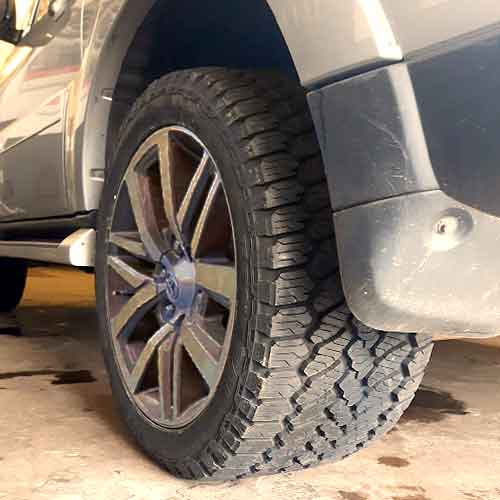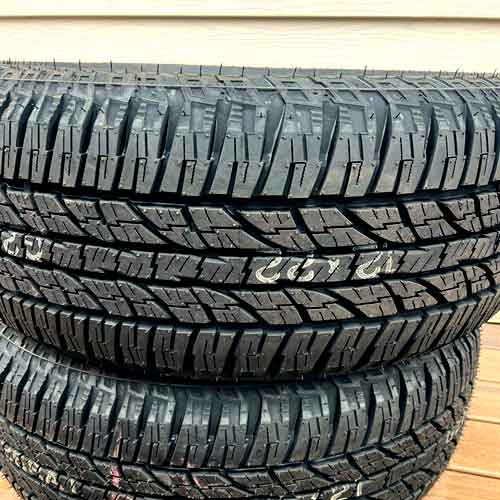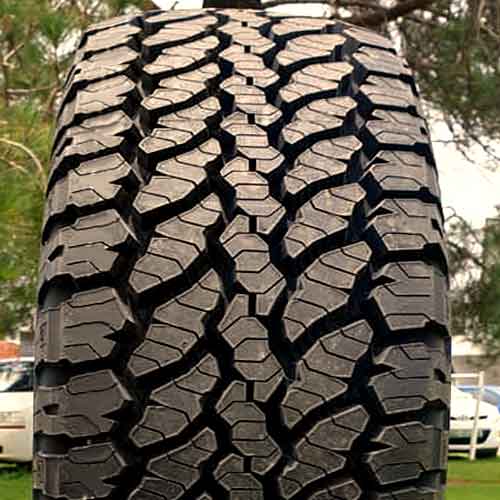Both the Yokohama Geolandar G015 and the General Grabber AT3 are all-terrain (A/T) tires where the focus of both tires is mostly on road comfort. But at the same time these tires don’t compromise on a lot when you take them off road.

Being a tire engineer from my perspective, the General Grabber AT3 provides a great dry grip without producing too much rolling resistance (so less fuel is consumed), this is because it uses a next generation tread compound which though also provides flexibility, it’s wet traction is just average (it’s okay, just not as impressive as it’s wet grip). And that’s where Yokohama Geolandar G015 comes in with it’s superior wet grip with numerous sipes which also earns it with better snow performance, though both have 3pmsfr.
Table of Contents
Tire’s Info
Let’s start with Yokohama Geolandar AT sizes.
- Available in 112 sizes, ranging from 15 to 22 inches (rim sizes).
- Sizes have load ratings in SL, XL, C, D and E.
- Weight range is 25 to 70 lbs.
- Available speed ratings are, R, S, T, and H.
- Tread depth ranges from, 12/32″ to 18/32″, where most of the sizes are seen in 17/32″.
- Gives 60k miles warranty for P metric and 50k for LT sizes.
General Grabber AT3, on the other hand comes with following specs.
- Comes in currently, 66 sizes, ranging from 15 to 22 inches.
- Speed Ratings are available in S, T and H (also one size, 275/40 R 20, is also available in V).
- SL and XL, only 2 Load Ratings are seen on all sizes.
- 25 to 45 lbs (weight range)
- M+S and the snowflake symbol ratings available on all sizes.
- LT sizes not available.
- 40k miles warranty (on all sizes).
Tread Appearance
Let’s start things off with the sides of Yokohama Geolandar A/T.

The tire provides a lot of biters throughout its tread. Well except for sidewalls, as towards outer edges, the lugs make stepped edges which provide a little chewing power off road.
These shoulder lugs towards inner sides make full depth notches joined by wave-like-pattern siping.
All these lugs are joined together form underneath with secondary layer.
This dual layered feature is also seen on inner ribs as well, and together they offer directional and lateral stability on highways.
In the middle, the center most rib is slightly narrower and has lugs with lateral grooves in them.
Whereas the surrounding ribs are equipped with both lateral and longitudinal grooves notches.
Though similar siping pattern continues on all these lugs.
On the other side, the General Grabber AT3 brings forth a pretty straight forward design.

The tire has a conventional 4 longitudinal channels where the outer are wider than the inner two.
The shoulder lugs are staggered and have notches towards both inner and outer edges, along with rectilinear siping.
These lugs bring a lot of on road handling stability as they are joined together from beneath with reinforced rubber foundations
The following circumferential channel in the middle have triangular shaped stone ejectors, which look very similar to BFG KO2 (review).
In the middle the tread has 3 unique ribs are connected with each other with foundation supports.
Due to their consistent design and irregular geometry they also make interlinked tread voids as well (which helps in dirt evacuation).
The sipes on all these lugs are full depth and have (similar to shoulder) design having rectilinear pattern.
Internal Construction
All-Terrain tires need to be tough as they go on various terrains and off-road things are very sharp and can puncture the tire in a heart-beat.
And here the most vulnerable area is the tire’s sidewalls, so it need protection the most.
Both tires have 2 ply polyester construction, with 2 steel belts and a single ply nylon, where on Yokohama Geolandar the cap ply is spirally wound whereas on other its not.
So although both tires have 2 ply sidewalls, General Grabber AT3 does not offer those plies reinforced with nylon covering.
Fuel Consumption
Fuel usage is directly proportional to rolling resistance of the tire, which is the dependent on tire’s weight and tread composition.
General Grabber AT3 is pretty good a sweeten the overall on road performance deal. As the tire is not available in LT sizes, it’s technically a passenger tire with such lighter weights.
And you know what lighter weights mean? “Significantly lowered rolling resistance values”, hence this tire is very great in saving you some fuel money, though even a better pick can be found in list of top coming A/T tires here, I just added new tire there (before Grabber AT3 was taking that spot).
The Yokohama Geolandar on the other side is not so great here because of it’s very sticky compound which produces a lot of rolling resistances.
Tread Life
The tread life of the tire is dependent on the tread depth of the tire which would tell how long a tire would last.
It also depends on the rubber compound a tire has. Some tires which are silica rich are softer, so they are more prone to wear out faster.
Both tires although vary in “giving you warranties” which by the way don’t tell you anything, the General Grabber AT3 is better here, even though the Geolandar AT provides you up to 18/32″ of tread depth.
Ride Quality
Ride quality besides, on road stability depends on two major factors, where tread noise comes in the category of smooth pavements, and overall comfort comes in both on and off road which tells you about the tire’s ability to absorb the shocks.
Noise
Noise is nothing but air moving around in the tread and it moves in two ways. One it comes in, mostly through the sides of the tire, generating whistling effect. And second it moves around and hit the tread surface to create resonance.
The General Grabber AT3 with closed up voids don’t let as much air to move around but the tire produces more groove resonance.
Groove resonance is just sound waves reflecting off the surface of the tread, and the elastic the rubber, the more it does that, so with the compound of Grabber AT3 provides that.
Yokohama Geolandar G015 on the other hand is the best in the business, as it handles the noise with better pitch sequencing and it’s lugs are designed in a way to not let a lot of air to come in as well.
Comfort
The overall comfort a tire brings has to do with it’s thickness and sponginess. The more soaking the rubber is, the more its able to dissolve the imperfections of the road (or you can say even off road).
Here internal construction of the tire and the rubber thickness matter as well, Yokohama Geolandar G015 is again one of the top performing ones.
Not only it’s higher silica density allows it to have a very spongy rubber, its deeper tread voids allows more area for vibration energy to settle down before reaching you.
Think of it as a secondary suspension.
Winter Performance
In order to perform better the all-terrain tires adapt to some winter tires’ features which include having a softer rubber and a lot of notches, so even without numerous siping (like severe snow tires), they still get to have 3 Peak Mountain Snowflake and M+S ratings.
Both of our boys here come with this class. So snow is not going to be a problem for them.
But still comparatively, the is overall Yokohama Geolandar G015 is going to impress you a little bit more when it comes to hard packed snow.
That’s because this terrain requires two things, flexible siping and snow grabbing abilities.
We’ve covered how Yokohama AT is flexible, and as for the snow grabbing, the tire’ multiple notches/in groove notches/biters are more than enough to make a great snow to snow contact, providing enhanced braking, acceleration and lateral stability.
Its also not so bad on ice as well, where A/T tires are generally not so great.
On Road Performance:
Highway performance is something, which is not expected too much out of all terrain tires, yet these two tires changed that and now it has become a myth.
Braking and Acceleration
Braking comes under straight grip of the tire, so here the tire’s ability to roll also has a big role to play. This grip of the tire is judges by look at the middle area of the tread which meets up with the surface the most (as whole tire’s pressure is on there).
Here overall General Grabber does things a lot better. It’s the least aggressive tire that you can get, having such packed shoulder lugs.
Yokohama Geolandar AT has more tread depth, which causes sloppy blocks movement while braking and acceleration, so grip is not as great here (in comparison), though the tire is overall pretty decent compared to other top performing A/T tires. Check them here: https://tiredriver.com/all-terrain-tires/
Cornering Abilities
Dry handling of the tire is calculated by considering the shoulder lugs. As the tire rolls over the curves, most of its’ weight is pressure towards the sides of the tire.
In other words, how much shoulder lugs meet up with the road on curves are crucial in determining the overall lateral traction.
Grabber AT3 offers a more compact shoulder lugs, so it’s able to produce better lateral traction, whereas Geolandar AT, as I showed you in the tread section, is filled with a lot of notches that eat away the space of that rubber.
Steering Feedback
All-Terrain tires are infamous for their slow response, that’s because with stronger durability (more no. of cap plies) they get heavier.
And the heavier the tire gets, the more susceptible it gets to over-steering.
The good thing about these two tire here is that, although the are both very light in weight, and that’s why go up to H in speed rating, but as the General Grabber AT3 is not available in LT sizes, it’s still offers better average overall steering experience.
Wet Performance
Wet performance is the expertise of tires where water evacuation is done properly.
Two things are fairly important when it comes to wet performance of the tire, the overall traction (grip and handling) and hydroplaning. Let’s evaluate both.
Wet Traction
On wet roads, all-terrain tires although have a lot of aid as they are equipped with full depth sipes, which have a wave like pattern (in some, which is even better).
General Grabber AT3 lacks due to it’s less silica density in it’s tread rubber. So although the tire a lot of siping, it’s not enough to produce as much traction values as the Geolandar.
Yokohama AT on the other side, does better with better flexible interlocking siping and a softer tread. It’s also better in hydroplaning which also plays a key role overall.
Hydroplaning
Hydroplaning is just floating of tires on water, as how fast a tire can move is calculated by float speeds.
The Geolandar AT has better float speeds as it’s shoulder voids are open and it has wide enough longitudinal channels, so water is able to move out in all direction.
General Grabber AT3 also offers a web of grooves, but its lugs are joined together which gate in the water and don’t allow to leave out easily, hence its not able to show as much hydroplaning resistance in comparison.
Off Road Traction
Off road there are a lot of terrain variations where some like mud are very challenging. Let’s consider them all one by one.
On Mud
On mud in order to maintain traction, you need self cleaning grooves, and all-terrain tires are too packed together to provide that.
That’s why mud tires are so good with it with highly voided design from where mud gets passed out easily.
For our A/T tires here, which are at the bottom in the list of All-terrain tires, in terms of aggressiveness, mud is a big no for them.
They simply can’t get themselves cleaned in time to offer traction.
On Rocks
On rocks you need durability, and 2 ply sidewalls of both tires are just average, so lighter terrains are okay for them, but don’t expect them to perform full on with rugged rock climbing.
They both lack in sidewall lugs as well so airing them down isn’t going to make things better as well.
Still with more biters Yokohama G015 would produce better results.
On Sand
On sand you need a tire with following features.
- It should be light in weight.
- Have a larger area of rubber to meet with the sand.
- Have durable rim locks and sidewall lugs.
On this soft terrain, airing down the tire is a must, as with lowered air pressure, the tire does a better job with extra foot-print.
Again both tires are just okay here, but if you have to pick one, you can go with Grabber AT3 with it’s lighter weight.
Summing
Both Yokohama Geolandar G015 and the General Grabber AT3 are very on-road aligned tires which do great on smooth pavements but lack slightly on rugged tracks (that’s why they have up to H in speed ratings).
Both have 3 peak mountain snowflake ratings as well, but Geolandar AT does better with it. In fact it does great on all sorts of wet surfaces, providing better lateral and horizontal aid.
But what I love the most about this tire, is how comfortable it is on highways.
Grabber AT3 is on the other side is one of the best dry road performing tire that you can have.
Thanks